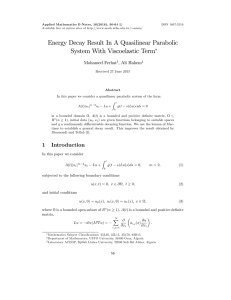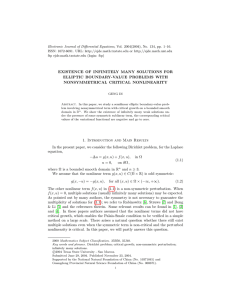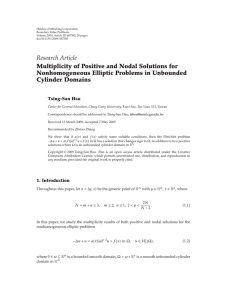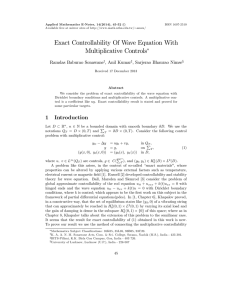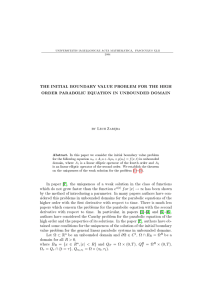Document 10524226
advertisement
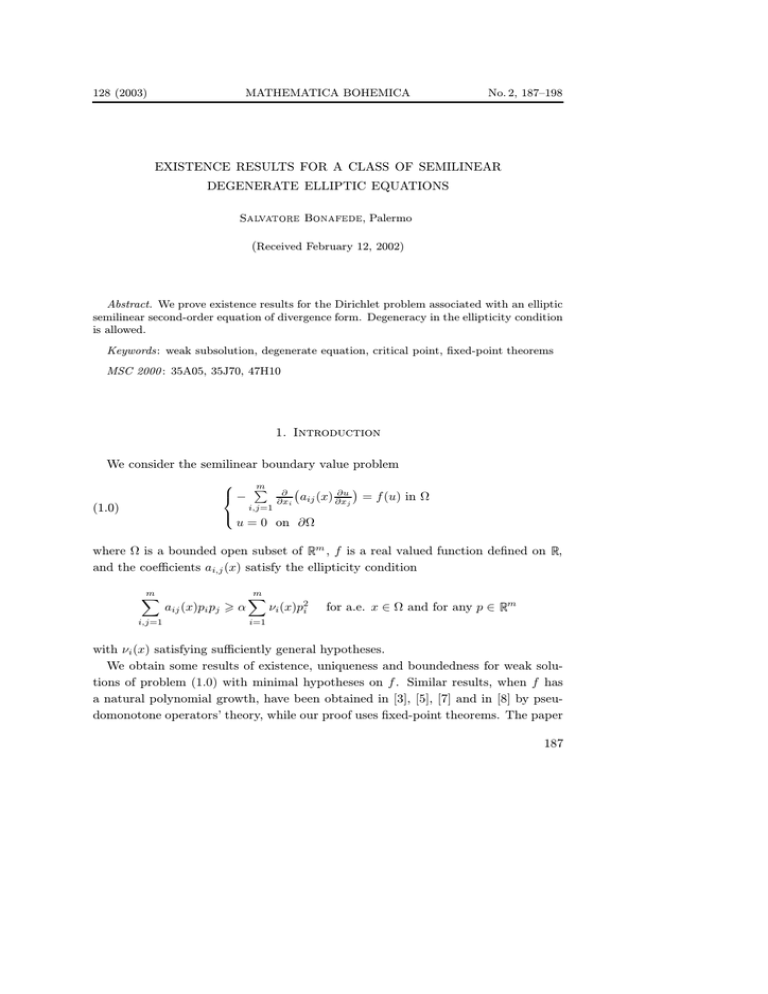
128 (2003)
MATHEMATICA BOHEMICA
No. 2, 187–198
EXISTENCE RESULTS FOR A CLASS OF SEMILINEAR
DEGENERATE ELLIPTIC EQUATIONS
, Palermo
(Received February 12, 2002)
Abstract. We prove existence results for the Dirichlet problem associated with an elliptic
semilinear second-order equation of divergence form. Degeneracy in the ellipticity condition
is allowed.
Keywords: weak subsolution, degenerate equation, critical point, fixed-point theorems
MSC 2000 : 35A05, 35J70, 47H10
1. Introduction
We consider the semilinear boundary value problem
m
P
−
(1.0)
i,j=1
∂
∂xi
∂u
aij (x) ∂x
= f (u) in Ω
j
u = 0 on ∂Ω
where Ω is a bounded open subset of m , f is a real valued function defined on ,
and the coefficients ai,j (x) satisfy the ellipticity condition
m
X
i,j=1
aij (x)pi pj > α
m
X
νi (x)p2i
for a.e. x ∈ Ω and for any p ∈ m
i=1
with νi (x) satisfying sufficiently general hypotheses.
We obtain some results of existence, uniqueness and boundedness for weak solutions of problem (1.0) with minimal hypotheses on f . Similar results, when f has
a natural polynomial growth, have been obtained in [3], [5], [7] and in [8] by pseudomonotone operators’ theory, while our proof uses fixed-point theorems. The paper
187
is structured as follows. In Sections 2 and 3 we state hypotheses and results. In
Section 4 we establish some useful lemmas and, finally, in Section 5 we prove our
main theorems.
2. Functional spaces
Let m be the Euclidean m-space with a generic point x = (x1 , x2 , . . . , xm ), Ω a
bounded open subset of m . The notation measx will indicate the m-dimensional
Lebesgue measure.
If u(x) is a measurable function defined in Ω, we will denote by |u|p (1 6 p 6 ∞)
the usual norm in the space Lp (Ω).
!
2.1. Let νi (x) (i = 1, 2, . . . , m) be a positive and measurable
function defined in Ω such that
νi (x) ∈ L1 (Ω),
where
m
P
i
1
gi
νi−1 (x) ∈ Lgi (Ω)
< 2 (gi > 1) if m > 3 (m = 2).
The symbol H 1 (νi , Ω) stands for the completion of C 1 (Ω) with respect to the norm
kuk1 =
Z Ω
∂u 2 21
νi (x)
|u| +
dx ;
∂x
i
i=1
2
m
X
H01 (νi , Ω) denotes the closure of C0∞ (Ω) in H 1 (νi , Ω).
Finally, H −1 (νi−1 , Ω) denotes the dual space of H01 (νi , Ω) (see also [5], [6] and [10]
for details concerning the weighted Sobolev spaces).
3. Hypotheses, problems and results
!
3.1. The coefficients aij (x) (i, j = 1, 2, . . . , m) are functions defined and measurable in Ω satisfying
!
(3.1)
aij (x) = aji (x),
aij (x)
p
∈ L∞ (Ω)
νi (x)νj (x)
3.2. There exists α > 0 such that for almost every x in Ω we have
m
X
i,j=1
188
(i, j = 1, 2, . . . , m).
aij (x)pi pj > α
m
X
i=1
νi (x)p2i
for any p ∈ m
.
Let a : H01 (νi , Ω) × H01 (νi , Ω) → be such that
a(u, v) =
Z X
m
aij (x)
Ω ij=1
and define
τ=
inf
u∈H01 (νi ,Ω)\{0}
∂u ∂v
dx,
∂xj ∂xi
a(u, u)
.
|u|2
In Section 4 we prove the following
Lemma 4.4. Let us assume that (2.1), (3.1), (3.2) hold. Then τ > 0 and there
exists u0 ∈ H01 (νi , Ω) such that τ = a(u0 , u0 ) and
Z
uu0 dx for any u ∈ H01 (νi , Ω);
a(u, u0 ) = τ
Ω
moreover, we can choose u0 > 0.
Definition 3.2. Let H be a Hilbert space, f , g ∈ C 1 (H, ), and let
E = {u ∈ H : g(u) = 0,
A point u0 ∈ H is a critical point of f |E if
h(t) : ] − ε, ε[→ E such that h(0) = u0 .
g 0 (u) 6= 0} .
d
dt f (h(t))|t=0
= 0 for all C 1 paths
"#%$'&(*)
3.3. If there exists u0 ∈ E such that f (u0 ) = min{f (u) : u ∈ E}, then
(f |E )0 (u0 ) = 0.
Theorem 3.4 (see, e.g., [2]). A point u0 ∈ E is a critical point of f |E if and only
if there exists λ ∈ such that f 0 (u0 ) = λg 0 (u0 ).
Now, if f ∈ C( ) satisfies the condition
u ∈ H01 (νi , Ω) ⇒ f (u) ∈ H −1 (νi , Ω),
we obtain the following well posed problem
+(*-,/.0%$
(3.1)
. Find a function u(x) ∈ H01 (νi , Ω) such that
Z X
m
Ω ij=1
aij (x)
∂u ∂v
dx = (f (u), v) (1)
∂xj ∂xi
for any v(x) ∈ H01 (νi , Ω).
(1) We denote by (·, ·) the duality pairing between H01 (νi , Ω) and H −1 (νi , Ω).
189
A function u(x) satisfying (3.1) is a weak solution of Problem (1.0).
"#%$'&(*)
3.5. When f does not depend on u, f ∈ H −1 (νi , Ω), the hypotheses
(2.1), (3.1), (3.2) are sufficient to ensure existence and uniqueness of a weak solution
of problem (1.0), moreover we have
kuk1,0 6 kf kH −1 (νi ,Ω) .
Proof follows from Lemma 4.1 and the Lax-Milgram theorem (see Remark 4.2 for
the definition of kuk1,0).
In Section 5 we prove
Theorem 5.1 (Existence, uniqueness and boundedness). Let us assume that
(2.1), (3.1), (3.2) hold and let f be Lipschitz continuous with a Lipschitz constant
L < τ.
Then there exists a unique weak solution u(x) of problem (1.0); moreover, u(x) ∈
∞
L (Ω) and
(5.0)
kuk∞ 6 γ(L, g, m, measx Ω).
Theorem 5.2. Let us assume that (2.1), (3.1), (3.2) hold and let f be a bounded
continuous function. Then Problem (1.0) has a weak solution u(x). Moreover, u(x) ∈
L∞ (Ω) and (5.0) holds.
4. Preliminary lemmas
Lemma 4.1. If the hypothesis (2.1) is satisfied then there exists a constant
C = C(m, gi , |νi−1 |gi ) such that
(4.1)
|u|2? 6 C
∂u 2 12
νi (x)
dx
∂x
i
Ω i=1
Z X
m
where 2? = 2m m − 2 +
m
P
i=1
1 −1
.
gi
for all u ∈ H01 (νi , Ω),
Moreover, the imbedding of H01 (νi , Ω) into L2 (Ω) is compact.
190
+(*132
(4.2)
Since
2gi
gi +1 .
. Let us fix mi =
m
P
i=1
1
mi
=
m
P
i=1
gi +1
2gi
=
∂u 1 ∂u 1
6 |νi−1 |g2i νi2
.
∂xi mi
∂xi 2
1
2
(see, for instance, [12])
(4.3)
Then
m+
m
P
i=1
1
gi
> 1, Sobolev’s imbedding theorem yields
|u|q 6 C(m, mi , q)
where q = m − 1 +
m
P
i=1
1 −1
.
mi
m 1
Y
∂u m
∂xi mi
i=1
From (4.2) and (4.3) we obtain
|u|
2?
m 1 ∂u m1 Y
1
2
|νi−1 |g2m
6C
.
i νi
∂x
i 2
i=1
Now, let {un } be a sequence of functions of H01 (νi , Ω) with equibounded norms
and let {Πk } be a sequence of open intervals in Ω such that
1. Πk ⊂ Πk+1 for any k ∈ 4 ,
2. lim Πk = Ω,
k→+∞
3. for any closed, bounded subset C of Ω there exists k : C ⊂ Πk , k > k.
Let us denote by W 1,1 (Π1 ) the usual Sobolev space on the set Π1 .
It follows that the norms of {un } in W 1,1 (Π1 ) are equibounded; in fact, applying
the Hölder inequality we obtain the following estimate:
kun kW 1,1 (Π1 ) =
6
Z
m X
∂un dx
Π1 i=1 ∂xi
m Z
X
1
2
|un | dx (meas Π1 ) 2 +
|un | dx +
Π1
Z
Π1
Z
i=1
Π1
1
dx
νi (x)
21
kun k1
6 const kun k1 .
Due to the compact imbedding of W 1,1 (Π1 ) into L1 (Π1 ) (see e.g. [1]) there is a
subsequence {u1,n } from {un } that converges a.e. in Π1 .
The same procedure can be done on each Πj for j = 2, 3, . . . . Hence we get a
system of sequences {uj,n }, n, j = 1, 2, . . . (where {uj,n } is a subsequence of {uj−1,n })
such that {uj,n } is convergent a.e. in Πj for j = 1, 2, . . ..
By the diagonals method we obtain that {un,n } converges a.e. in Ω and, by virtue
(4.1), in L2 (Ω).
191
"#%$'&(*)
4.2. If the hypothesis (2.1) holds, then
R P
m
Ω
i=1
∂u 2
νi (x)| ∂x
| dx
i
1/2
con-
stitutes an equivalent norm in H01 (νi , Ω). We will denote this norm by kuk1,0.
Lemma 4.3. Let u(x) ∈ H01 (νi , Ω) and k > 0, then the function min(u, k) belongs
to H01 (νi , Ω).
+(*132
. Define v = min(u, k) for u ∈ H01 (νi , Ω) and let {ϕn } be a sequence of
functions of C0∞ (Ω) such that
lim kϕn − uk1 = 0.
n→+∞
Let ψn = min(ϕn , k) for any n ∈ 4 .
By regularization, we can prove that ψn belongs to H01 (νi , Ω); moreover, because
the norms of {ψn } are equibounded in H01 (νi , Ω), there exists a subsequence that
weakly converges in H01 (νi , Ω). On the other hand,
|v(x) − ψn (x)| 6 |u(x) − ϕn (x)|
a.e. in Ω,
so {ψn } converges to v in L2 (Ω).
The conclusion now follows easily.
+(*1325327689$:$'&
(4.4)
4.4. We observe that
τ = inf a(u, u) : u ∈ H01 (νi , Ω),
Z
Ω
u2 dx = 1 ,
and we define f, g : H01 (νi , Ω) → as
f (u) = a(u, u),
g(u) =
Z
u2 dx − 1.
Ω
Let
E = {u ∈ H01 (νi , Ω) : g(u) = 0}.
Then
τ = inf f (u).
u∈E
Let {un } be a sequence such that a(un , un ) → τ ; from (3.2) and Remark 4.2 we have
that {un } is bounded in H01 (νi , Ω), so there exist {unk }, u0 ∈ H01 (νi , Ω) such that
unk * u0 weakly in H01 (νi , Ω). By the compact imbedding of H01 (νi , Ω) into L2 (Ω)
R
(Lemma 4.1), unk → u0 strongly in L2 (Ω), which gives Ω u20 dx = 1. Therefore
u0 ∈ E.
192
Finally, by virtue of
τ 6 a(u0 , u0 ) 6 lim inf a(unk , unk ) = τ
k→+∞
we obtain
τ = a(u0 , u0 )
and f attains its minimum at u0 ∈ E. By Remark 3.3 we have
(f |E )0 (u0 ) = 0.
Accordingly, Theorem 3.4 yields
(f )0 (u0 ) = λ(g)0 (u0 ) for some λ ∈ or
a(u, u0 ) = λ
Z
for any u ∈ H01 (νi , Ω).
uu0 dx
Ω
Choosing u = u0 we have
τ = a(u0 , u0 ) = λ
Z
Ω
u20 dx ⇒ τ = λ.
Obviously u0 ∈ H01 (νi , Ω) is such that
a(u, u0 ) = τ
Z
uu0 dx
Ω
for any u ∈ H01 (νi , Ω).
Next, Lemma 4.3 implies that if u satisfies (4.4) then |u| also satisfies (4.4), therefore
we can choose u0 to be non-negative.
5. Proof of main results
Define G : H −1 (νi−1 , Ω) → H01 (νi , Ω) as
G(g) = w where w is a weak solution of
m
P
−
i,j=1
∂
∂w
∂xi (aij (x) ∂xj )
= g in Ω
w = 0 on ∂Ω
Remark 3.5 ensures that G is a linear continuous map. For u ∈ H01 (νi , Ω) define
F (u) = G(f (u)). Then a fixed point u of F is a solution of problem (1.0).
193
+(*1325327;<%3(*%$
5.1. We claim that
u ∈ L2 (Ω) ⇒ f (u) ∈ L2 (Ω).
Indeed,
|f (u)| 6 |f (u) − f (0)| + |f (0)| 6 L|u| + |f (0)|,
thus
Z
2
|f (u)| dx 6 2L
2
Ω
Z
|u|2 dx + 2|f (0)|2 measx Ω.
Ω
We proceed to show that F is a contractive mapping. We see at once that
for any u, v ∈ H01 (νi , Ω).
|f (u) − f (v)|2 6 L|u − v|2
By (3.1) and Remark 4.2 we deduce that
αkuk21,0 6 a(u, u) = (f (u), u) 6 c|f (u)|2 kuk1,0
or
kuk1,0 6
c
|f (u)|2 .
α
Consequently, G is continuous from L2 (Ω) → L2 (Ω). Therefore
(5.1)
|F (u) − F (v)|2 = |G(f (u) − f (v))|2 6 kGk? |f (u) − f (v)|2
6 LkGk? |u − v|2 .
Since τ |u|22 6 a(u, u) =
R
Ω
f (u)u dx 6 |f (u)|2 |u|2 or
|G(f (u))|2
1
6 ,
|f (u)|2
τ
it results that
kGk? 6
1
.
τ
We conclude from (5.1) that
|F (u) − F (v)|2 6
L
|u − v|2
τ
and finally that, since L < τ , F has a fixed point in H01 (νi , Ω).
Now, let us fix k > 0, then from (3.1) for v = u − min(u, k) we get
(5.2)
194
αkvk21,0
6L
Z
Ω
|u||v| dx +
Z
|f (0)||v|.
Ω
Lemma 4.1 and the definition of v imply
Z
|u||v| dx 6
Ω
Z
v 2 dx + k
Ω(u>k)
Z
v dx
Ω(u>k)
2
6 |v|22? [measx Ω(u > k)]1− 2? + k
Z
v dx
Ω(u>k)
2
6 c2 kvk21,0 [measx Ω(u > k)]1− 2? + k
Z
v dx.
Ω(u>k)
Therefore from (5.2) we obtain
(5.3)
kvk21,0 (α
2
− Lc [measx Ω(u > k)]
1− 22?
) 6 (Lk + |f (0)|)
Z
v dx.
Ω(u>k)
Recalling that
lim measx Ω(u > k) = 0
k→+∞
we can certainly choose k̃ > 0 such that for any k > k̃ we have
2
Lc2 [measx Ω(u > k)]1− 2? 6
α
.
2
We apply this inequality to (5.3) obtaining
(5.4)
kvk1,0 6
1
2c
[measx Ω(u > k)]1− 2? (|f (0)| + Lk) for any k > k̃.
α
Let h, k be real numbers, h > k > k̃. Then one has
|v|2? =
Z
?
|u − k|2 dx
Ω(u>k)
21?
1
> (h − k)[measx Ω(u > h)] 2? ;
furthermore, (5.4) and Lemma 4.1 yield
(5.5)
1
[measx Ω(u > h)] 2? 6
2c2
1
(|f (0)| + Lk)[measx Ω(u > k)]1− 2? .
α(h − k)
Next, if k > 0, we get
2? −1
2
2c2
(|f (0)| + 2Lk)2 2? −2 [measx Ω(u > k)]1− 2?
αk
Ω(u>k)
Z
1− 22?
2? −1
?
2c2
2
?
(|f (0)| + 2Lk)2 2 −2
.
u dx
6
αk 2? −1
Ω(u>k)
measx Ω(u > k) 6
1
k 2?
Z
?
u2 dx,
195
Now, the first term of the above inequality goes to zero as k → +∞, so we can fix
k1 (> k̃) such that
2? −1
2c2
1− 2
(|f (0)| + 2Lk1 ) [measx Ω(u > k1 )] 2? 2 2? −2 6 k1 .
α
(5.6)
Moreover, one has
2c2
2c2
(|f (0)| + Lk) 6
(|f (0)| + 2Lk1 ) if 0 6 k 6 k1 .
α(h − k)
(h − k)
(5.7)
Combining (5.5) and (5.7) we obtain
1
[measx Ω(u > h)] 2? 6
2c2
1− 1
(|f (0)| + 2Lk1 ) [measx Ω(u > k)] 2?
α(h − k)
for any h, k ∈ such that k1 6 k < h 6 2k1 .
Assuming in [k1 , +∞[ that
ϕ(k) =
(
1
[measx Ω(u > k)] 2? if k1 6 k 6 2k1
0 if k > 2k1
we get
ϕ(h) 6
?
2c2
(|f (0)| + 2Lk1 ) [ϕ(k)]2 −1
α(h − k)
for any h, k ∈ such that k1 6 k < h 6 2k1 , and from Stampacchia’s lemma (see
[11], p. 212) we deduce
ϕ(k1 + d) = 0,
where d is the first term of (5.6).
We can obtain the same conclusion for −u, so the proof of the theorem is complete.
+(*132=32>;<%3(*%$
5.2. Set F as in Theorem 5.1. Since the imbedding of
into L (Ω) is compact, we have that F is also compact from L2 (Ω) into
L (Ω); therefore, by Schaefer’s fixed point theorem, it will be sufficient to prove that
the set of all solutions of the equation
H01 (νi , Ω)
2
(5.8)
is unbounded.
196
2
u = µF (u)
for 0 < µ < 1
Indeed, if u satisfies (5.8), then u is solution of
m
− P
i,j=1
therefore
τ |u|22
∂ ∂u aij (x)
= µf (u) in Ω
∂xi
∂xj
u = 0 on ∂Ω,
6 a(u, u) = µ
or
Z
1
f (u)u dx 6 M (measx Ω) 2 |u|2
Ω
1
M (measx Ω) 2
|u|2 6
.
τ
Now, if we fix in (3.1) v = u − min(u, k), k > 0 we get
αkuk21,0
6M
Z
v dx 6 M |v|2? [measx Ω(u > k)]
2? −1
2?
.
Ω
This inequality, as in the previous theorem, implies
kuk∞ < +∞.
?A@ )1BDC=.0DEGF3%$H%B1I
. Research was supported by the grant MURST 60% of
Italy.
References
[1] Adams, R. A.: Sobolev Spaces. Academic Press, New York, 1975.
[2] Ambrosetti, A.: Critical points and nonlinear variational problems. Mem. Soc. Math.
France 49 (1992).
[3] Bonafede, S.: Quasilinear degenerate elliptic variational inequalities with discontinuous
coefficients. Comment. Math. Univ. Carolin. 34 (1993), 55–61.
[4] Bonafede, S.: A weak maximum principle and estimates of ess supΩ u for nonlinear degenerate elliptic equations. Czechoslovak Math. J. 121 (1996), 259–269.
[5] Drábek, P., Kufner, A., Nicolosi, F.: De Gruyter Series in Nonlinear Analysis and
Applications, New York, 1997.
[6] Guglielmino, F., Nicolosi, F.: W -solutions of boundary value problems for degenerate
elliptic operators. Ricerche di Matematica Suppl. 36 (1987), 59–72.
[7] Guglielmino, F., Nicolosi, F.: Existence theorems for boundary value problems associated with quasilinear elliptic equations. Ricerche di Matematica 37 (1988), 157–176.
[8] Ivanov, A. V., Mkrtycjan, P. Z.: On the solvability of the first boundary value problem for certain classes of degenerating quasilinear elliptic equations of second order.
Boundary value problems of mathematical physics (O. A. Ladyzenskaja, ed.). Vol. 10,
Proceedings of the Steklov Institute of Mathematics, A.M.S. Providence (1981, issue 2),
pp. 11–35.
[9] Ladyzenskaja, O. A., Ural’tseva, N. N.: Linear and Quasilinear Elliptic Equations. Academic Press, New York, 1968.
197
[10] Murthy, M. K. V., Stampacchia, G.: Boundary value problems for some degenerate-elliptic operators. Ann. Mat. Pura Appl. 80 (1968), 1–122.
[11] Stampacchia, G.: Le probleme de Dirichlet pour les equations elliptiques du second
ordre a coefficients discontinus. Annal. Inst. Fourier 15 (1965), 187–257.
[12] Troisi, M.: Teoremi di inclusione per spazi di Sobolev non isotropi. Ricerche Mat. 18
(1989), 3–24.
Author’s address: Salvatore Bonafede, Dipartimento di Economia dei Sistemi AgroForestali, University of Palermo, Viale delle Scienze, 90128 Palermo, Italy, e-mail: bonafede
@dmi.unict.it.
198
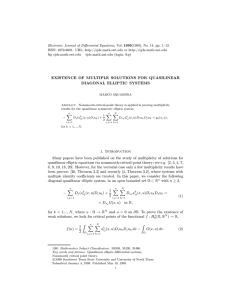

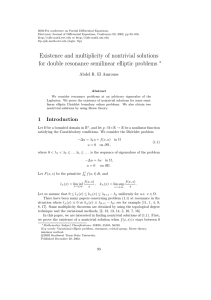
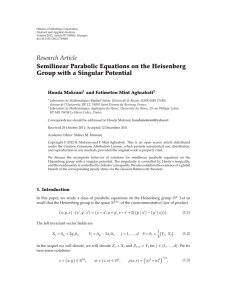


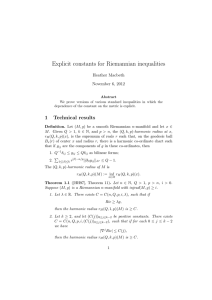

![5.5 The Haar basis is Unconditional in L [0, 1], 1 < 1](http://s2.studylib.net/store/data/010396305_1-450d5558097f626a0645448301e2bb4e-300x300.png)
